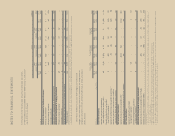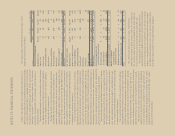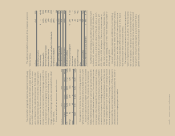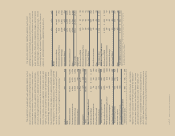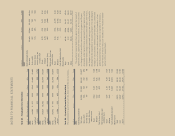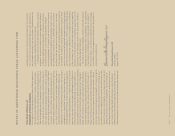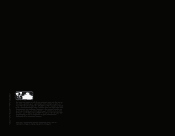Sara Lee 2011 Annual Report Download - page 113
Download and view the complete annual report
Please find page 113 of the 2011 Sara Lee annual report below. You can navigate through the pages in the report by either clicking on the pages listed below, or by using the keyword search tool below to find specific information within the annual report.
One One
Percentage Percentage
Point Point
In millions Increase Decrease
Effect on total service and interest components $1 $(1)
Effect on postretirement benefit obligation 9 (7)
Net Periodic Benefit Cost and Funded Status The components of
the net periodic benefit cost and curtailment gains associated with
continuing operations were as follows:
In millions 2011 2010 2009
Components of defined benefit
net periodic cost (income)
Service cost $÷«2 $÷«1 $÷«3
Interest cost 568
Net amortization and deferral (13) (13) (11)
Net periodic benefit cost (income) $÷(6) $÷(6) $÷«–
Curtailment (gains) $÷«– $÷«– $(12)
The net periodic benefit cost associated with the North American
fresh bakery operations is recognized in discontinued operations as
the buyer is expected to assume all of the postretirement benefit
liabilities associated with those businesses.
The net periodic benefit income in 2011 was unchanged from the
prior year. The increase in net periodic benefit income in 2010 as
compared to 2009 was driven by lower service costs, lower interest
costs as a result of the lower accumulated benefit obligation at the
start of the year as compared to the prior year, and an increase in
net amortization and deferral income. The increase in amortization of
prior service cost credits was due to the impact of a prior year plan
amendment on the amount of unamortized prior service credits.
The amount of the prior service credits, net actuarial loss and
net initial asset that is expected to be amortized from accumulated
other comprehensive income and reported as a component of net
periodic benefit cost during 2012 is $10 million of income, nil and
$2 million of income, respectively.
During the third quarter of 2009, the corporation approved a
change to its U.S. postretirement medical plan. Effective January 1,
2010, the corporation no longer subsidizes retiree medical coverage
for U.S. salaried employees and retirees. After this date, retirees
have access to medical coverage but have to pay 100% of the pre-
mium. This change resulted in the recognition of a plan amendment
which reduced the accumulated postretirement benefit obligation
by $50 million with an offset to unamortized prior service cost in
accumulated other comprehensive income.
Measurement Date and Assumptions Beginning in 2009, a fiscal
year end measurement date is utilized to value plan assets and
obligations for the corporation’s postretirement health-care and life-
insurance plans pursuant to the accounting rules. Previously, the
corporation used a March 31 measurement date.
The weighted average actuarial assumptions used in measuring
the net periodic benefit cost and plan obligations for the three
years ending July 2, 2011 were:
2011 2010 2009
Net periodic benefit cost
Discount rate 5.1% 6.3% 6.4%
Plan obligations
Discount rate 5.3 5.1 6.3
Health-care cost trend assumed
for the next year 8.0 8.0 8.5
Rate to which the cost trend is
assumed to decline 5.0 5.0 5.0
Year that rate reaches the
ultimate trend rate 2017 2016 2016
The discount rate is determined by utilizing a yield curve based
on high-quality fixed-income investments that have a AA bond rating
to discount the expected future benefit payments to plan participants.
Assumed health-care trend rates are based on historical experience
and management’s expectations of future cost increases. A one-
percentage-point change in assumed health-care cost trend rates
would have the following effects:
110/111 Sara Lee Corporation and Subsidiaries







